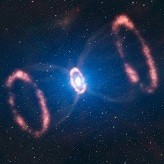Supernova reproduction in lab

 Crédit : ESO/L. Calçada
Crédit : ESO/L. Calçada
In 1987, in the Large Magellanic Cloud, a supernova (SN1987A) explodes. Being very close to Earth, this supernova has been particularly well studied and has made it possible to validate one of the most important theoretical models of neutron star formation with the detection of neutrinos coming from the densest parts of the imploding star. However, this supernova has not yet revealed all of its mysteries.
The first hotspots surrounding the central star were observed a few months after the explosion. Such hotspots are created because of a radiative shock (a radiation-emitting shock) in the circumstellar medium, which is also created because of the star’s explosion. Many theories explaining why the hotspots appeared were developed. However, the calculated time for the hotspots’ first appearance was in years, in contrast to what was observed.
Thibault Michel, PhD student at the Laboratoire pour l’Utilisation des Lasers Intenses (LULI, a joint research unit of CNRS / École polytechnique - Institut Polytechnique de Paris / CEA / Sorbonne Université) and his international collaborators, reproduced this astrophysical phenomenon at a smaller scale in lab. Using a very energetic laser to irradiate a solid target, they were able to witness for the first time the deceleration of a radiative shock generated by irradiation. This allowed them to prove that the deceleration could be a source of hydrodynamic instabilities (Rayleigh-Taylor), which play an important part in the structure and dynamic of the circumstellar medium. In opposition to actual astrophysical theories, they estimated that this deceleration could explain why the hotspots appeared in a few months, as observed in SN1987A.
These experiments allow a better understanding the hotspots’ observations, but for the researchers that are mainly the first steps towards new supernova evolution theories.
 Left: Astronomical observations of SN1987A by Hubble to distinguish the central circumstellar ring and the two outer rings. Right: The rapid evolution of hot spots in the central circumstellar ring of SN1987A observed by Hubble.
Left: Astronomical observations of SN1987A by Hubble to distinguish the central circumstellar ring and the two outer rings. Right: The rapid evolution of hot spots in the central circumstellar ring of SN1987A observed by Hubble.
 Support l'X
Support l'X